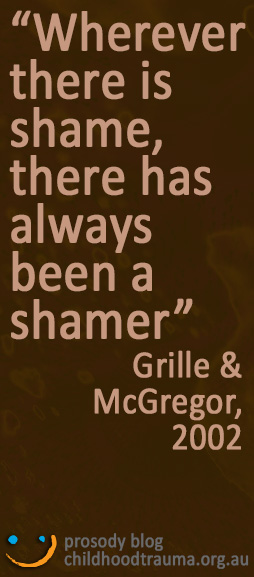
Shame
This article was authored by Deborah McKenzie, Team Leader,
Training and Professional Development Program, at the Australian Childhood Foundation.
Have you ever thought about how children, young people, and adults have come to hold onto a platform of Shame?
I have. And in my role as an educator and school counsellor, I often wondered how I could best help support a young person who held onto such a negative image of themselves when I didn’t. How could I best help support their learning needs and engagement in the school context when they lacked so much confidence or were avoidant in presenting their work? How could I teach them that they had so much to offer the world when all they could see were the deficits and the things they perceived were so horrid about themselves? I discovered that if I connected with them relationally and showed empathy and understanding for their experiences in life that I could make a difference to how they began to view themselves and the world around them. Thus, I went on a quest to learn more for myself about the powerful emotion of ‘Shame’ – one of the most destructive and detrimental of all of the emotions.
Shame has been referred to by Mills (et al 2010) as:
“The key emotional barometer of a person’s felt worth or value that motivates and regulates thinking, feeling and behaviour related to preserving acceptance by others”
Shame is also referred to as:
- A primary emotion – brief, intense painful feelings, feeling of inadequacy
- A fear-based internal state of being, accompanied by beliefs of being unworthy and unlovable
Shame is a dejected, humiliation-based emotional state in which the self-desires to shrink and hide the exposed self “(Lewis, 1971, 1992 cited in Feiring et al, 2002)
Five things Children and Young People who have difficulty with managing shame might do:

1. Find it difficult to accept responsibility for their behaviour
2. Struggle with any sort of feedback
3. Avoid situations where they might lose out or not be able to perform
4. Find it hard to make decisions for themselves, in case they get it wrong
5. Seek out others who feel the same way as them
It might also manifest in the following physical, psychological and emotional ways:
Physical manifestations will be highlighted by:
- Blushing, nausea, rapid heart rate, slumped body posture, perspiration, avoidance of eye contact, withdrawal, dizziness, and hanging of the head
Psychological manifestations might include:
- Depression, lacking concentration, overwhelmedness, many conflicting thoughts, feeling and behaviours, forgetfulness, paranoia and other behaviours that can lead to cognitive ‘stuckedness’
Emotional manifestations can look like:
- Fear, loneliness, doubt, anger, dissociation, sadness, anxiety, jealousy, self-pity
Whilst not exhaustive, there are manifestations of shame which I imagine many of you may well be familiar with when working with your clients, students or children & young people. Shame is an impediment and can affect all relationships; parent/child, teacher/student, therapist/client. It moves to impact the inner world and security of an individual and disallows trust.
So where does this very detrimental emotion come from?
Shame can result from an early developmental loss which could be either real or perceived. Research suggests that by the time a child is two or three, the child is forming self-consciousness and self-awareness. They are able to perceive others and have an understanding of others’ perceptions of them. They have the ability to evaluate themselves with regards to what others think and feel about them and they can become very sensitive to the actual or perceived judgements by others. Negative parental responses and feedback to the child often sets them up to have a learned and ingrained shame response.
Such parental responses might include:
- Love withdrawal, Disappointment; Anger, Disapproval, Disgust, Physical punishment, Contempt, Humiliation and Hostility (Mills et. al., 2010)
- Caregivers not teaching the difference between doing wrong and being wrong (bad). e.g. “Max, lying is really bad. You lied to me.” (so you’re a really bad person)” (Gerlach 2013)
- Ignoring, lack of affection, lack of affirmation, name-calling, belittling, degrading, being impatient, becoming easily frustrated and being emotionally or even physically absent
It would be pertinent here to consider how all of this correlates with Complex Relational Trauma.
 Complex relational trauma overwhelms our capacity to cope. It is disconnecting and isolating. It is blaming, stigmatising and shaming. A child who has experienced this type of trauma and holds much shame may show us behaviours such as: envy, anger, and anxiety, effects of sadness, depression, depletion, loneliness, isolation and avoidance. They will highlight to us their inadequacy, their powerlessness and at times their own self-disgust. This however, may not be done using words; it may be more so through showing us ‘rage’ which is an emotion very closely associated with the presence of shame. Sometimes, a child can move through shame to guilt. This is a good thing as it allows for them to acknowledge their behaviour. Reparation and repair can take place as well as an attunement to self and other. But, if a child does not have access to someone who will be gentle, warm and attuned to the child’s needs in early life, then this child grows a distorted view of self and the way s/he impacts others in their environment. Therefore, the child will do everything to shield themselves from the reinforcement of shame and take themselves to a place of ‘protection’. That is to say, to protect from the overwhelmedness of the feeling of pain and grief from past experiences. They could bully or be aggressive/violent towards others, move to destroy relationships, substance use and self-harm.
Complex relational trauma overwhelms our capacity to cope. It is disconnecting and isolating. It is blaming, stigmatising and shaming. A child who has experienced this type of trauma and holds much shame may show us behaviours such as: envy, anger, and anxiety, effects of sadness, depression, depletion, loneliness, isolation and avoidance. They will highlight to us their inadequacy, their powerlessness and at times their own self-disgust. This however, may not be done using words; it may be more so through showing us ‘rage’ which is an emotion very closely associated with the presence of shame. Sometimes, a child can move through shame to guilt. This is a good thing as it allows for them to acknowledge their behaviour. Reparation and repair can take place as well as an attunement to self and other. But, if a child does not have access to someone who will be gentle, warm and attuned to the child’s needs in early life, then this child grows a distorted view of self and the way s/he impacts others in their environment. Therefore, the child will do everything to shield themselves from the reinforcement of shame and take themselves to a place of ‘protection’. That is to say, to protect from the overwhelmedness of the feeling of pain and grief from past experiences. They could bully or be aggressive/violent towards others, move to destroy relationships, substance use and self-harm.
They can deny and defend: “It wasn’t me”, “You always blame me,” “You’re always picking on me”, “You are always looking to catch me out”, or they may lie about situations.
The core pathology to shame is denial. The hopelessness people with a shame response feel is the very reason they find is so difficult to seek help. So…how do we, in the helping professions, get them to “come out from under the covers?”
Dr. Brene Brown, in a recent TED talk titled: ‘The Unspoken Epidemic of Shame’ (2012) suggested that EMPATHY IS THE ANTIDOTE OF SHAME. She said that if we put shame in a petri dish, it needs three things to grow:
- Secrecy
- Silence
- Judgement
If you put it in with empathy, – it can’t survive.
One of the key goals in getting people to acknowledge their shame is to get to the core of their pain. Easier said than done! But it is not about the ‘curing’; it is about the ‘caring’. Legitimise the pain. Bradshaw (2012) suggests that: “To heal toxic shame, they have to embrace their shame”. And therefore allow for people to develop some compassion for themselves and to allow for people to take charge of their own personal power; therefore coming from a strengths based perspective. It is really important to also acknowledge that the shame was not their fault.
No- one is born ‘ashamed’ and as (Grille & McGregor, 2002) state: “Wherever there is shame, there has been a shamer”.
So in order to support children it is essential to offer a safe and secure environment. One in which the adults are build relational connection and attune to a child’s needs. One where the child experiences unconditional regard, patience, care, understanding and respect, as well as love. One where the health and wellbeing of a child is considered as being paramount and that genuineness occurs. And remember; repetition, consistency and predictability in these measures is what makes the difference!
Questions to consider:
- How can we assist children and young people in not linking comments about their behaviour with their core identity?
- Consider how we can gain the trust of a child/young person so that we are able to assist their shame- based behaviour and help them to feel worthy and loveable.
- Think about some of the children/adolescents you work with and consider what might bring on a ‘shame attack’ in them. Can you ascertain what the triggers might be?
- In what ways might we assist to empower (allow for them to feel competent and capable) a child/young person who feels powerless?
